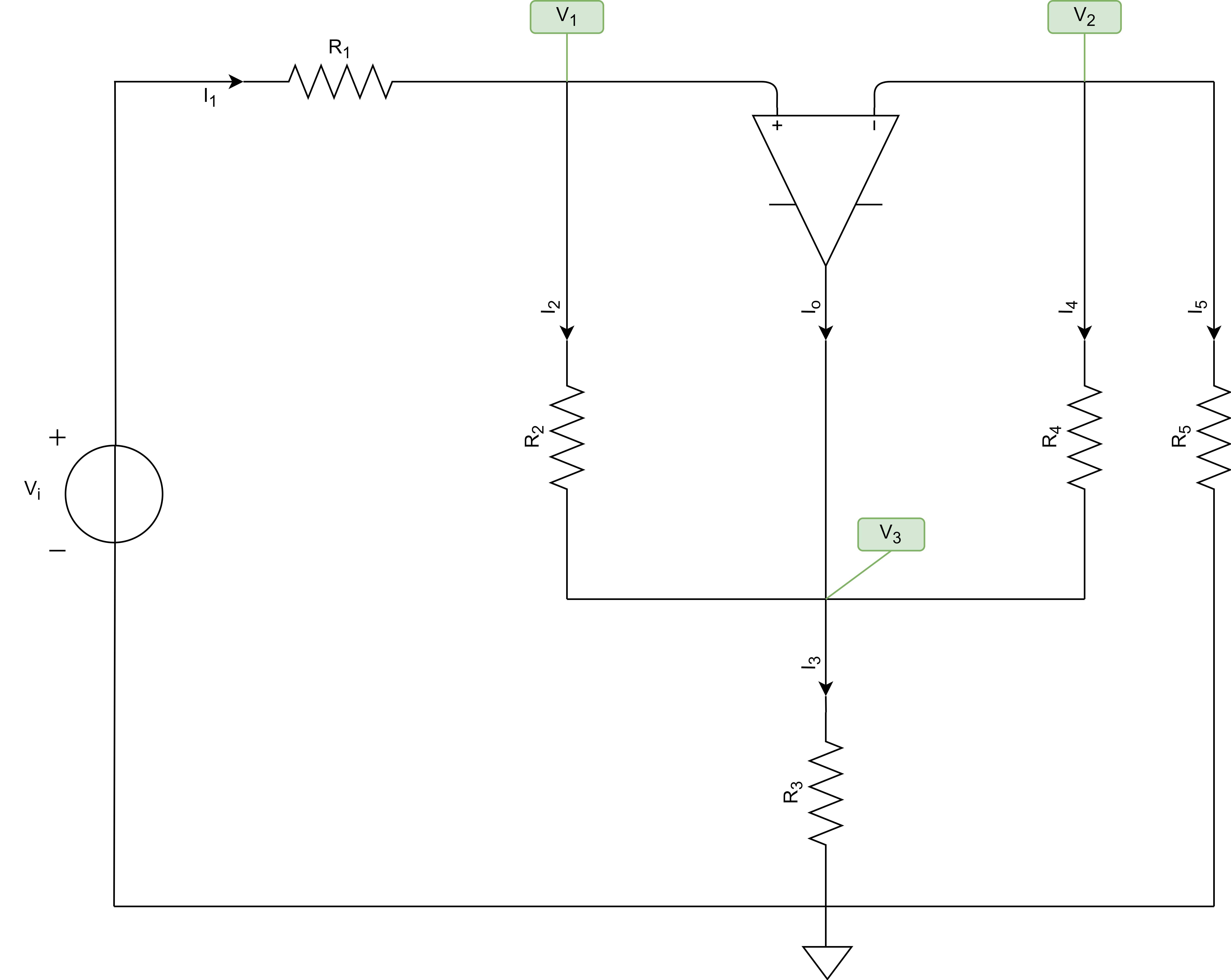First, I will present a method that uses Mathematica to solve this problem. When I was studying this stuff I used the method all the time (without using Mathematica of course).
Well, we are trying to analyze the following opamp-circuit:

When we use and apply KCL, we can write the following set of equations:
$$
\begin{cases}
\text{I}_2=\text{I}_2\\
\\
0=\text{I}_4+\text{I}_5\\
\\
\text{I}_\text{o}+\text{I}_1+\text{I}_3=\text{I}_2+\text{I}_4
\end{cases}\tag1
$$
When we use and apply Ohm's law, we can write the following set of equations:
$$
\begin{cases}
\text{I}_1=\frac{\text{V}_\text{i}-\text{V}_1}{\text{R}_1}\\
\\
\text{I}_2=\frac{\text{V}_1-\text{V}_3}{\text{R}_2}\\
\\
\text{I}_3=\frac{\text{V}_3}{\text{R}_3}\\
\\
\text{I}_4=\frac{\text{V}_2-\text{V}_3}{\text{R}_4}\\
\\
\text{I}_5=\frac{\text{V}_2}{\text{R}_5}
\end{cases}\tag2
$$
Substitute \$(2)\$ into \$(1)\$, in order to get:
$$
\begin{cases}
\frac{\text{V}_1-\text{V}_3}{\text{R}_2}=\frac{\text{V}_1-\text{V}_3}{\text{R}_2}\\
\\
0=\frac{\text{V}_2-\text{V}_3}{\text{R}_4}+\frac{\text{V}_2}{\text{R}_5}\\
\\
\text{I}_\text{o}+\frac{\text{V}_\text{i}-\text{V}_1}{\text{R}_1}+\frac{\text{V}_3}{\text{R}_3}=\frac{\text{V}_1-\text{V}_3}{\text{R}_2}+\frac{\text{V}_2-\text{V}_3}{\text{R}_4}
\end{cases}\tag3
$$
Now, using an ideal opamp, we know that:
$$\text{V}_x:=\text{V}_+=\text{V}_-=\text{V}_1=\text{V}_2\tag4$$
So we can rewrite equation \$(3)\$ as follows:
$$
\begin{cases}
\frac{\text{V}_x-\text{V}_3}{\text{R}_2}=\frac{\text{V}_x-\text{V}_3}{\text{R}_2}\\
\\
0=\frac{\text{V}_x-\text{V}_3}{\text{R}_4}+\frac{\text{V}_x}{\text{R}_5}\\
\\
\text{I}_\text{o}+\frac{\text{V}_\text{i}-\text{V}_x}{\text{R}_1}+\frac{\text{V}_3}{\text{R}_3}=\frac{\text{V}_x-\text{V}_3}{\text{R}_2}+\frac{\text{V}_x-\text{V}_3}{\text{R}_4}
\end{cases}\tag5
$$
Now, we can solve for the transfer function:
$$\mathscr{H}:=\frac{\text{V}_x}{\text{V}_\text{i}}=\frac{\text{R}_2\text{R}_5}{\text{R}_2\text{R}_5-\text{R}_1\text{R}_4}\tag6$$
Where I used the following Mathematica-code:
In[1]:=Clear["Global`*"];
V1 = Vx;
V2 = Vx;
FullSimplify[
Solve[{I1 == I2, 0 == I4 + I5, I1 + Io + I3 == I2 + I4,
I1 == (Vi - V1)/R1, I2 == (V1 - V3)/R2, I3 == V3/R3,
I4 == (V2 - V3)/R4, I5 == V2/R5}, {Io, I1, I2, I3, I4, I5, Vx,
V3}]]
Out[1]={{Io -> (R2 (R3 + R4 + R5) Vi)/(R3 (R1 R4 - R2 R5)),
I1 -> (R4 Vi)/(R1 R4 - R2 R5), I2 -> (R4 Vi)/(R1 R4 - R2 R5),
I3 -> (R2 (R4 + R5) Vi)/(R3 (-R1 R4 + R2 R5)),
I4 -> (R2 Vi)/(R1 R4 - R2 R5), I5 -> (R2 Vi)/(-R1 R4 + R2 R5),
Vx -> (R2 R5 Vi)/(-R1 R4 + R2 R5),
V3 -> (R2 (R4 + R5) Vi)/(-R1 R4 + R2 R5)}}
My equation was also confirmed using LTspice.
Now, using \$\text{R}:=\text{R}_1=\text{R}_2=\text{R}_3=\text{R}_5\$, we can simplify the transfer function as follows:
$$\mathscr{H}=\frac{\text{R}}{\text{R}-\text{R}_4}\tag7$$
So, we get:
$$\text{V}_x=\frac{100\cdot10^3}{100\cdot10^3-98\cdot10^3}\cdot100\cdot10^{-3}=5\space\text{V}\tag8$$
Running the code again with your resistor values, we get:
In[2]:=Clear["Global`*"];
V1 = Vx;
V2 = Vx;
R1 = R;
R2 = R;
R3 = R;
R5 = R;
FullSimplify[
Solve[{I1 == I2, 0 == I4 + I5, I1 + Io + I3 == I2 + I4,
I1 == (Vi - V1)/R1, I2 == (V1 - V3)/R2, I3 == V3/R3,
I4 == (V2 - V3)/R4, I5 == V2/R5}, {Io, I1, I2, I3, I4, I5, Vx,
V3}]]
Out[2]={{Io -> -(((2 R + R4) Vi)/(R (R - R4))), I1 -> (R4 Vi)/(R (-R + R4)),
I2 -> (R4 Vi)/(R (-R + R4)), I3 -> ((R + R4) Vi)/(R (R - R4)),
I4 -> -(Vi/(R - R4)), I5 -> Vi/(R - R4), Vx -> (R Vi)/(R - R4),
V3 -> ((R + R4) Vi)/(R - R4)}}
In[3]:=Clear["Global`*"];
V1 = Vx;
V2 = Vx;
Vi = 100*10^(-3);
R1 = 100*1000;
R2 = 100*1000;
R3 = 100*1000;
R4 = 98*1000;
R5 = 100*1000;
FullSimplify[
Solve[{I1 == I2, 0 == I4 + I5, I1 + Io + I3 == I2 + I4,
I1 == (Vi - V1)/R1, I2 == (V1 - V3)/R2, I3 == V3/R3,
I4 == (V2 - V3)/R4, I5 == V2/R5}, {Io, I1, I2, I3, I4, I5, Vx,
V3}]]
Out[3]={{Io -> -(149/1000000), I1 -> -(49/1000000), I2 -> -(49/1000000),
I3 -> 99/1000000, I4 -> -(1/20000), I5 -> 1/20000, Vx -> 5,
V3 -> 99/10}}
In[4]:=N[%3]
Out[4]={{Io -> -0.000149, I1 -> -0.000049, I2 -> -0.000049, I3 -> 0.000099,
I4 -> -0.00005, I5 -> 0.00005, Vx -> 5., V3 -> 9.9}}


